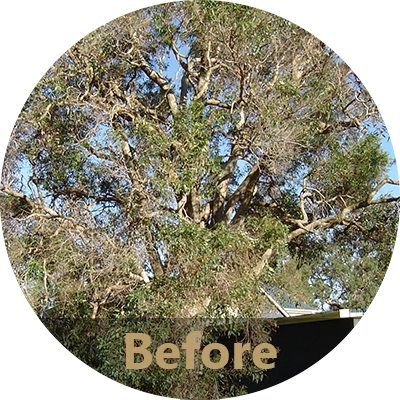Tree Pruning: Enhancing Health, Beauty and Safety

Pruning is the process of selectively removing branches or parts of a tree to improve its structure, health, or appearance. Tree pruning is a vital aspect of tree care that offers numerous benefits for both the trees and the surrounding environment. By understanding the biology and biomechanics of trees, the principles of pruning and employing proper techniques, we can enhance the health, safety, and aesthetic appeal of your trees.
Benefits of Tree Pruning:
Improved Tree Health: Pruning removes dead, diseased, or damaged branches, enhancing overall tree health by reducing the risk of infection and promoting growth.
Enhanced Safety: Regular pruning helps mitigate the risk of falling branches, especially during storms or high winds, reducing potential hazards to property and people.
Aesthetic Appeal: Proper pruning improves the shape, structure, and appearance of trees, enhancing the visual appeal of landscapes and urban environments.
Increased Sunlight Penetration: Thinning and selective pruning allow more sunlight to reach the tree's interior and surrounding vegetation, promoting healthy growth and biodiversity.
Enhanced Air Circulation: Crown thinning and pruning improve air circulation within the canopy, reducing the risk of fungal diseases and pest infestations.
Preservation of Views: Strategic pruning can preserve scenic views and sights, particularly in residential areas or public spaces. This can often be difficult to achieve whilst complying with council regulations.
Service Line Clearance: Pruning helps maintain clearance around power lines and service cables, reducing the risk of service disruptions and ensuring public safety.
Prevention of Property Damage: Properly pruned trees are less likely to interfere with buildings, fences, and other structures, minimising the risk of property damage over time.
Encouragement of Fruit Production: Pruning fruit trees promotes fruit production by directing energy to fruit-bearing branches and improving air circulation around fruit clusters.
Long-Term Tree Management: Regular pruning helps shape and train young trees, establishing strong branch structure and reducing the need for corrective pruning as they mature.
Mitigation of Pest and Disease Spread: Prompt removal of diseased or infested branches helps prevent the spread of pests and diseases to healthy parts of the tree or neighbouring trees.
Types of Pruning
Crown Maintenance
Deadwooding: The removal of dead or dying branches from a tree's canopy. Deadwooding helps improve the tree's health, safety, and appearance by eliminating potential hazards and reducing the risk of branch failure.
Crown Thinning: The selective removal of interior branches and foliage to reduce the density of the tree's canopy. Crown thinning improves air circulation, sunlight penetration, and overall tree health by reducing competition between branches and promoting even growth.
Selective Pruning: Targeted pruning of specific branches to achieve desired outcomes such as shaping, balancing, or promoting new growth. Selective pruning requires careful assessment and consideration of the tree's structure, health, and aesthetic goals.
Formative Pruning: Pruning performed on young trees to establish a well-balanced and structurally sound framework. Formative pruning helps shape the tree's growth, correct structural defects, and promote healthy development over time.
Crown Modification
Reduction Pruning: The strategic removal of branches to reduce the overall size or spread of a tree's canopy. Reduction pruning is performed to maintain clearance from structures or service lines, improve aesthetics, and mitigate potential hazards.
Crown Lifting: The removal of lower branches to raise the height of the tree's canopy above ground level. Crown lifting creates clearance for pedestrians, vehicles, or structures beneath the tree while preserving the overall canopy structure and health.
Pollarding: A pruning technique involving the removal of all branches from the main trunk, typically performed only on deciduous trees to promote a dense regrowth of foliage. Pollarding is often used for ornamental purposes or to control the size and shape of trees in urban landscapes.
Remedial/Restorative Pruning: Pruning performed to address specific issues such as disease, storm damage, or structural weaknesses within the tree's canopy. Remedial pruning aims to restore the tree's health, vigor, and structural integrity through targeted corrective measures.
Line Clearance: Pruning performed to maintain clearance around power lines or other utility lines to minimise the risk of contact and potential hazards. Line clearance pruning follows strict guidelines and safety standards to ensure compliance with regulations and prevent service disruptions.
When to Prune:
The timing of tree pruning varies depending on factors such as tree species, climate, and your specific pruning goals. However, as a general guideline pruning trees in winter to early spring is often considered ideal for pruning many tree species.
During the dormant season, pruning can be less stressful for trees, as they are not actively growing. Additionally, pruning during winter to early spring helps promote new growth once the warmer weather arrives.
It's important to note that some trees, particularly those that flower in spring, are best pruned after flowering to avoid cutting off potential blooms. Additionally, trees that are prone to pests or disease may benefit from pruning during dry periods to minimise the risk of infection.
Overall, it's important to assess each tree individually and consider its specific needs and characteristics before determining the optimal time for pruning.
Why choose Aussie Tree Services
While some minor pruning tasks can be tackled by the homeowner, larger or more complex pruning jobs should be entrusted to qualified and certified arborists. It's essential for us to understand your reasons for pruning before we recommend any cutting. Our team here at Aussie Tree Services have the knowledge, experience, and equipment to safely and effectively prune trees while preserving their health and beauty.
All pruning carried out by our team will be in compliance with Australian Standards AS4373:2007 and local council regulations.
